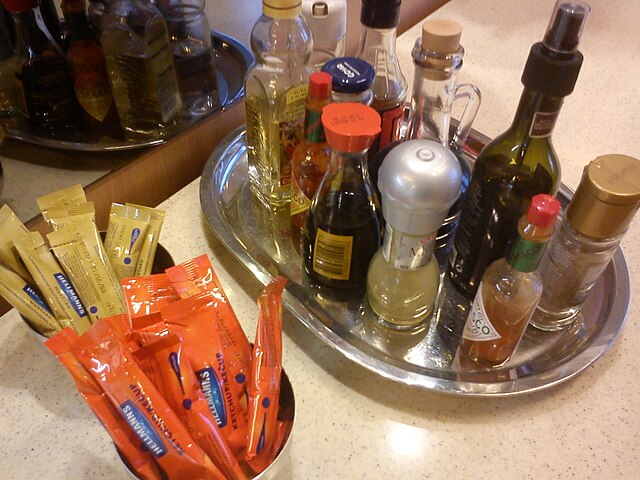Condiment
Substance added to food for flavour From Wikipedia, the free encyclopedia
A condiment is a preparation that is added to food, typically after cooking, to enhance the flavour,[1] to complement the dish or to impart a specific flavor. Such specific flavors generally add sweetness or pungency, or sharp or piquant flavors.[2] The seasonings and spices common in many different cuisine arise from global introductions of foreign trade.Condiments include those added to cooking to impart flavor, such as barbecue sauce and soy sauce, those added before serving such as mayonnaise in a sandwich, and those added tableside to taste, such as ketchup with fast food. Condiments can also provide other healthy benefit to diets that lack micronutrients.[3]


Definition

The exact definition of a condiment varies. Some definitions encompass spices and herbs, including salt and pepper,[4] using the term interchangeably with seasoning.[5] Others restrict the definition to include only "prepared food compound[s], containing one or more spices", which are added to food after the cooking process, such as mustard, ketchup or mint sauce.[5]
The Culinary Institute of America defines condiments as an "aromatic mixture" that "accompanies food", giving the examples of chutney, pickles and some sauces.[6]
Types
Condiments added during cooking to add flavor:[2] includes barbecue sauce, compound butter, teriyaki sauce, soy sauce, Marmite and sour cream.
Condiments added prior to serving: for example, in a sandwich made with ketchup, mustard or mayonnaise.
A table condiment or table sauce is served separately from the food and added to taste by the diner.[2] Many, such as mustard or ketchup, are available in single-serving packets, commonly when supplied with take-out or fast food meals. In traditional Asian restaurant settings, common condiments such as soy sauce, vinegar, chili oil, and shichimi are available.

Etymology
The term condiment comes from the Latin condimentum, meaning "spice, seasoning, sauce" and from the Latin condire, meaning "preserve, pickle, season".[7] The term originally described pickled or preserved foods, but its meaning has changed over time.[8]
History
Condiments were known in historical Ancient Rome, India, Greece and China. There is a myth that before food preservation techniques were widespread, pungent spices and condiments were used to make the food more palatable,[9] but this claim is not supported by any evidence or historical record.[10] The Romans made the condiments garum and liquamen, a similar and at times synonymous preparation, by crushing the innards of various fish and then fermenting them in salt, resulting in a liquid containing glutamic acid, suitable for enhancing the flavour of food. The popularity of these sauces led to a flourishing condiment industry.[7] Apicius, a cookbook based on fourth and fifth century cuisine, contains a section based solely on condiments.[7]
Global uses
When global trade was established, spices and seasoning were among the common commodities that were traded. Many of the popular spices from around the world were exchanged, giving rise to the usage of foreign seasonings in many cuisines. India, Asia, and China introduced basil, cardamom, cinnamon, clove, garlic, ginger, mace, mustard, nutmeg, onion, tamarind, and turmeric.[11] The Mediterranean and Middle East countries introduced bay leaf, coriander, cumin, dill, fennel, fenugreek, rosemary, sage, sesame, and thyme.[11] North America and Latin American countries provided allspice, annatto, chile peppers, chocolate, and sassafras.[11]. All of these spices and seasonings are used in traditional recipes from their respected originated countries. The development of many different dishes and cuisine around the world are dependent on the introduction of these foreign spices and seasonings.
Micronutrients
Condiments can provide healthy benefits. Micronutrient deficiencies are prevalent in Asia.[12][13] To combat lack of nutrition certain condiments are added to food. Common condiments added to help with micronutrient deficiency are fish sauce, soy sauce, seasonings, and bouillon cubes. Studies taken in nine different Asian countries suggest that iodine and iron are common micronutrients deficient in many diets.[3] By using iodized salt, the iodine intake can increase 9-80% of the Nutrient reference value(NRV).[3] The addition of bouillon cubes can increase iron intake 3-40% of the NRV.[3]
Gallery
- Chrain (horseradish sauce)
- Ajika, spicy sauce in Caucasian cuisine
- Packets of duck sauce
- Hungarian Erős Pista
See also
- Condiments by country (category)
- Dip – Type of sauce
- Garnish – Decoration added to food or drink
- List of brand name condiments
- List of condiments
- List of fish sauces
- List of foods – List of lists of food products
- List of mustard brands
- Non-brewed condiment – Malt vinegar substitute
- Seasoning – Process of supplementing food via herbs, salts, or spices
- Herb – Plant used for food, medicine or perfume
- Spice – Food flavoring
- Relish – Cooked, pickled, or chopped vegetable or fruit used as a condiment
- Pickling – Procedure of preserving food in brine or vinegar
- Ingredient – Part of a mixture
References
External links
Wikiwand - on
Seamless Wikipedia browsing. On steroids.



















